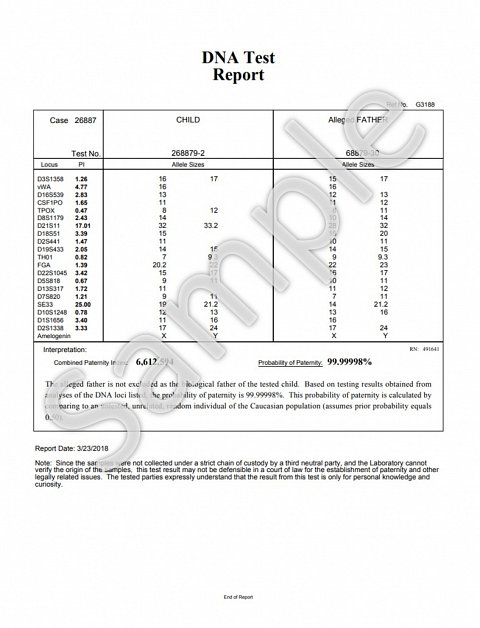-
Paternity Test
review on March 29, 2018
by Craig Macpherson

At a Glance
Summary
The Identigene test delivered the service that had been promised, and I was happy to receive a definitive result. I particularly appreciated the supporting information provided with the report and the option to purchase the test in-store or online was a bonus.
However, certain aspects of the communication were confusing and putting the wet swabs directly into paper envelopes made me worry that there could be cross-contamination of the samples.
That said, these relatively minor issues didn’t affect the end-result and I would be happy to use Identigene if I ever needed to take a paternity test again.
Full Review
Identigene is a company with a long history in paternity testing. It was founded in 1993 and started carrying out testing four years later. Soon after being acquired by Sorenson Genomics in 2007, the paternity tests were made available in stores nationwide. Since then, the company has changed hands again and is now part of DNA Diagnostics Center (DDC), the organization behind a range of other brands (e.g. HomeDNA and GPS Origins). The paternity test is now available in over 20,000 retail outlets across the US, including Walmart, Rite Aid and CVS Pharmacy.
Product Expectations
Although Identigene is now owned by DDC, it has its own dedicated website. Images on the homepage showed the kit used by the company previously, next to a picture of a new HomeDNA Identigene kit. As well as this home DNA kit, I read that the company carries out legal tests, for use in child custody disputes and immigration applications.
The homepage included a brief three-step list of ‘How it works’, but there was also a full page dedicated to the process of testing. I was impressed to see that there was a separate set of instructions for those in New York, where you need a doctor or lawyer to authorize the testing.
There wasn’t much information about what the kit would include. However, I did find a video showing how to use the swabs to take the samples and there was also a comprehensive FAQs page.
Ordering Experience
I purchased the test from Walmart. There was a helpful tool that allowed me to find the nearest store that sold Identigene tests, using my zip code. However, I order my groceries online and noticed that I could also purchase the test from the Walmart website. I was surprised to see that it was only $24.99, which was much cheaper than other paternity tests I’d seen. However, reading through the product description on this page, I found out that I would have to pay a $119 lab fee when submitting the samples.
I added it to my cart and was given the option to log in to/set-up a Walmart account or checkout as a guest. I chose the second option and was prompted to enter my details, including my name, address, email, and phone number. I was given two delivery options, a free service that would take about two weeks or a $5.29 service that would arrive in around a week. I chose the free option and went through to the payment page. There were loads of payment options, including PayPal, Amex Express Checkout, Visa Checkout, Masterpass and Chase Pay. I was also the option to simply enter my card details into a form, which is the option I went for.
Before clicking to complete the order, I checked through the terms and conditions to ensure there wasn’t anything that concerned me. I read that I should inform the company before testing if the two alleged fathers were related, and if any of the participants had undergone a blood transfusion or specific type of stem cell transplant. If not, the accuracy of results could not be guaranteed. Considering how important this information was to the outcome of the test, I was surprised that I hadn’t seen this mentioned anywhere else. The terms and conditions also didn’t say what would happen to my sample once it had been analyzed, apart from a line that informed me that it wouldn’t be returned. Overall though, I didn’t find anything particularly worrying, so clicked to complete my order.
When the kit arrived, within the estimated timeframe, I was surprised to find that it was still the old design, rather than the new I’d seen advertised on the site. Inside, there was equipment (swabs and sample envelopes) for three participants, a mother, a child, and an alleged father. I was only testing myself and the alleged father, so didn’t need all three, but was impressed that these had been included at no extra cost.
There was also a set of instructions, prepaid return postage, and a ‘Patient Information & Payment Form’. This started with a message informing me that I could enter my details and pay the lab fee online, for faster processing. The form included a web address, which I entered into my browser. I completed the order online, using the kit barcode to link my kit to the account I set up. It took me a while to find this, as the instructions told me to look for it in the upper right corner of my Order Form. I didn’t have anything labelled ‘Order Form’ in my kit, but I guessed that this referred to the Patient Information & Payment Form. However, the only number on this page that looked as though it could be the barcode was in the bottom right corner of the form. Luckily this worked but, until I received the results, I was slightly worried that I’d used the wrong one. I guessed that these instructions may have been for the new-style kits I’d seen on the website.
The samples were painless and easy to take, though I was surprised that we were instructed to put the swabs “directly into the sample envelopes”. As each of the three swabs we both used had been in our mouths for at least 30 seconds, we were unsurprised to find that some moisture seeped through these paper envelopes. This was not only a bit unpleasant, but made me worry that that my samples could get contaminated with the DNA from the other participant (and vice versa).
Two days after sending the samples back, I received an email to confirm that they had reached the lab. However, I was a bit confused, as this email was from ‘DDC’. It started with “Thank you for choosing DDC to perform your DNA test.” (which I didn’t think I had) and made no mention of Identigene. Although the website had made clear that the brand was now a part of HomeDNA, at this point, I wasn’t aware that both brands were owned by DDC. In fact, I hadn’t seen anything on the Identigene or Walmart websites that even mentioned DDC, so found it slightly concerning to be contacted by what seemed to be a completely different company.
The Results
Another two days later, I received an email (again from DDC, with no mention of Identigene) informing me that my results were ready. This email again started by thanking me “for choosing DDC for your DNA testing needs” and then informed me that my results would be accessible for 90 days. I was a bit surprised by this, as I’d assumed I’d have unlimited access to them.
There was a helpful list of instructions that told me how to access my results in the account I’d set up when registering the kit and paying the lab fee. I logged in with no problems and downloaded the report (shown below).

My report.
I was pleased to find that the ‘Combined Paternity Index’ and ‘Probability of Paternity’ were in a slightly larger font than the rest of the results, making it easy to see straight away. This percentage seemed to confirm that the man tested was my biological father, though I was slightly worried when I read the paragraph underneath, which explained that the result meant the “alleged father is not excluded as the biological father”. This seemed a lot less certain.
I was also not sure what the ‘Combined Paternity Index’ was and struggled to take any meaning from the table. However, going back to my account, I was pleased to find a document, available in English and Spanish, that provided explanations of various aspects of the report. This started by explaining a bit about DNA and the processes that had been used in the analysis. It then went on to provide details about how to interpret different sections, including the paternity index and probability of paternity. I was relieved to read that any probability of paternity above 99% meant that the man tested was most likely the biological father.
This document wasn’t as easy to see in my account as I would have expected and would have been quite easy to miss. However, it was helpful in allaying my initial concerns and improving my understanding of the different parts of the report.
Summary
The Identigene test delivered the service that had been promised, and I was happy to receive a definitive result. I particularly appreciated the supporting information provided with the report and the option to purchase the test in-store or online was a bonus.
However, certain aspects of the communication were confusing and putting the wet swabs directly into paper envelopes made me worry that there could be cross-contamination of the samples.
That said, these relatively minor issues didn’t affect the end-result and I would be happy to use Identigene if I ever needed to take a paternity test again.


